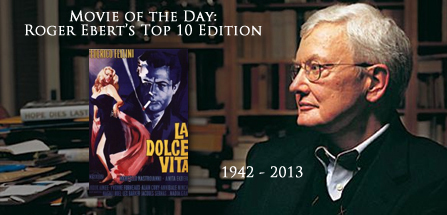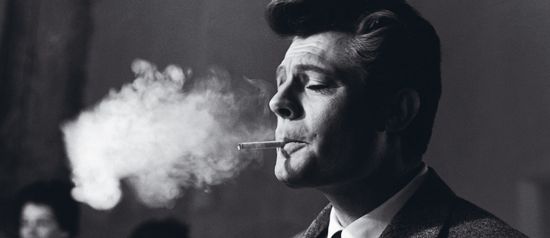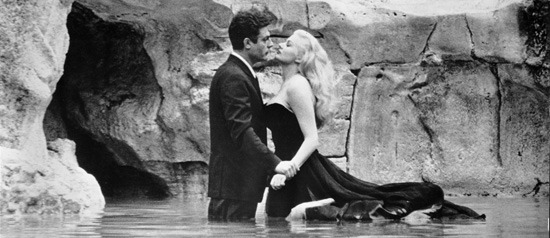The Film: La Dolce Vita (1960)
The Principals: Federico Fellini (director), Marcello Mastroianni, Anouk Aimee, Alain Cuny
The Premise: A tabloid journalist goes to crazy parties, sleeps with beautiful women, travels to exotic locales, and still isn’t happy.
Is it any good? Like every other movie we’ve reviewed for Ebert Tribute Week, it’s goddamn fantastic. It’s a movie that lures you in with lush cinematography, gorgeous actresses, and the charismatic cool of Marcello Mastroianni only to sucker-punch you in the throat.
The film’s structure is repetitious and symmetrical by design, as we follow journalist Marcello Rubini (Mastroianni) through a cycle of seven (possibly non-consecutive) nights and dawns. Every night is the same – fast cars, glamorous parties, and the promise of love (or at least incredible sex) – and yet every morning brings the knowledge that whatever happened overnight was transient, corrupt, ultimately a mirage. It’s a wearying journey, and at the end we realize that we haven’t just been travelling in circles, we’ve gone further and further down. As an audience, we’ve been conditioned to expect some kind of redemption for characters like Marcello – Fellini doesn’t provide that. Instead, he subverts salvation at every turn, insistent on showing us the dark side of every dream, the humanity of every untouchable woman, the trauma behind the perfect home life, and the empty promise of divinity.
The inescapable conclusion Fellini leaves us with is that there may be no such thing as “the sweet life”.
The Ebert factor:
Roger Ebert proved him wrong.
By his own admission, La Dolce Vita was “just about the first movie review [he] ever wrote”, when he was a sophomore at the University of Illinois. Ebert writes “I now consider La Dolce Vita one of the greatest films I’ve seen, but obviously that was not my first impression”. Which makes perfect sense, really – it’s not a movie that can be appreciated by the very young (except maybe in the broad aesthetic sense). In his “Great Movies” review, Ebert would later write:
“When I saw La Dolce Vita in 1960, I was an adolescent for whom ‘the sweet life’ represented everything I dreamed of: sin, exotic European glamour, the weary romance of the cynical newspaperman. When I saw it again, around 1970, I was living in a version of Marcello’s world; Chicago’s North Avenue was not the Via Veneto, but at 3 a.m. the denizens were just as colorful, and I was about Marcello’s age.
When I saw the movie around 1980, Marcello was the same age, but I was 10 years older, had stopped drinking, and saw him not as a role model but as a victim, condemned to an endless search for happiness that could never be found, not that way. By 1991, when I analyzed the film a frame at a time at the University of Colorado, Marcello seemed younger still, and while I had once admired and then criticized him, now I pitied and loved him. And when I saw the movie right after Mastroianni died, I thought that Fellini and Marcello had taken a moment of discovery and made it immortal. There may be no such thing as the sweet life. But it is necessary to find that out for yourself.”
Ebert’s journey, then, is a stark counterpoint to Rubini’s – a hopeful mirror image. Where the fictional journalist endures an endless cycle of disappointment, Ebert found a way to break free. He quit drinking, founded a partnership that changed the face of film criticism, and got married to an amazing woman. He championed the work of others, screened underappreciated films at EbertFest, and was effusive with praise and joy for what he loved. And when confronted with challenges that would have silenced most men, he found ways to move forward, to dig deeper, to reveal himself to his audience. If he had quit writing after the cancer struck, no one would have blamed him – but we would not be mourning him the same way right now. Roger Ebert was a man who lived until he died. He connected with people, he engaged with life, and he didn’t fuck around chasing endless mirages or ephemeral promises of salvation – Ebert created his own, day by day, with every new review, tweet, or personal connection.
“The sweet life” exists (contrary to what Fellini might think), and Roger Ebert lived it.
“Life always has an unhappy ending, but you can have a lot of fun along the way; and everything doesn’t have to be dripping in deep significance.”
Random anecdotes: Nico (muse for Andy Warhol, Leonard Cohen, and the Velvet Underground) shows up in a sustained cameo as herself. It’s not particularly flattering.
The famous opening scene (where a statue of Christ the Labourer is brought into Rome suspended by cables from a helicopter) incited outrage at the Vatican, who thought it was mocking Christ’s second coming (hell, maybe it was). The film was banned in Spain until 1975.
Fellini originally wanted Henry Fonda to play the role of Steiner (Rubini’s intellectual friend), but he turned it down; and producer Dino de Laurentiis left the project when Fellini refused to cast Paul Newman in the lead.
Cinematic Soulmates: Celebrity. Eyes Wide Shut. Cinema Paradiso. 8 ½.



